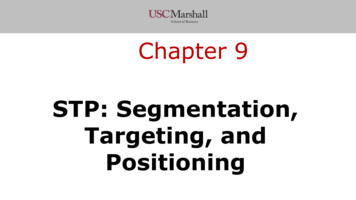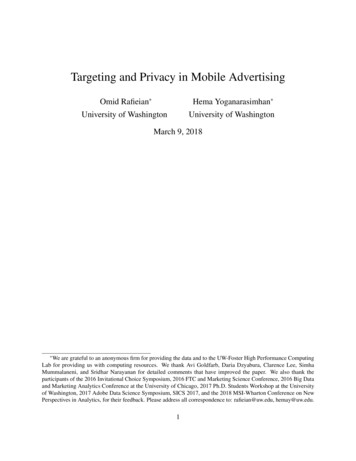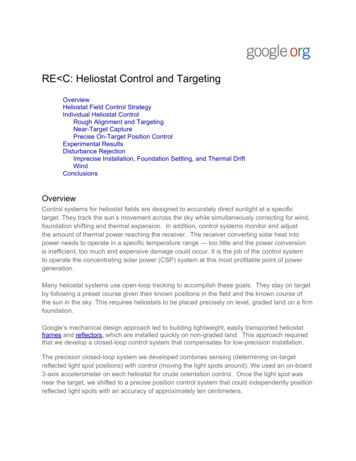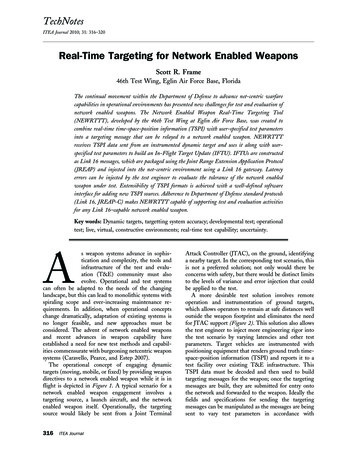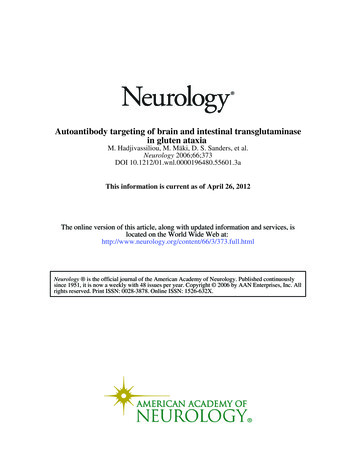
Transcription
Autoantibody targeting of brain and intestinal transglutaminasein gluten ataxiaM. Hadjivassiliou, M. Mäki, D. S. Sanders, et al.Neurology 2006;66;373DOI 10.1212/01.wnl.0000196480.55601.3aThis information is current as of April 26, 2012The online version of this article, along with updated information and services, islocated on the World Wide Web htmlNeurology is the official journal of the American Academy of Neurology. Published continuouslysince 1951, it is now a weekly with 48 issues per year. Copyright 2006 by AAN Enterprises, Inc. Allrights reserved. Print ISSN: 0028-3878. Online ISSN: 1526-632X.
Autoantibody targeting of brain andintestinal transglutaminase ingluten ataxiaM. Hadjivassiliou, MD; M. Mäki, MD; D.S. Sanders, MD; C.A. Williamson, PhD; R.A. Grünewald, DPhil;N.M. Woodroofe, MD; and I.R. Korponay-Szabó, MDAbstract—Objective: To investigate the presence of autoantibody deposition against type 2 tissue transglutaminase (TG2;a reliable marker of the whole spectrum of gluten sensitivity) in the jejunal tissue and brain of patients with gluten ataxiaand in control subjects. Methods: The authors evaluated jejunal biopsy samples from nine patients with gluten ataxia andseven patients with other causes of ataxia for the presence of TG2-related immunoglobulin deposits using double-colorimmunofluorescence. Autopsy brain tissue from one patient with gluten ataxia and one neurologically intact brain werealso studied. Results: IgA deposition on jejunal TG2 was found in the jejunal tissue of all patients with gluten ataxia andin none of the controls. The intestinal IgA deposition pattern was similar to that seen in patients with overt and latentceliac disease and in those with dermatitis herpetiformis. Widespread IgA deposition around vessels was found in thebrain of the patient with gluten ataxia but not the control brain. The deposition was most pronounced in the cerebellum,pons, and medulla. Conclusions: Anti–tissue transglutaminase IgA antibodies are present in the gut and brain of patientswith gluten ataxia with or without an enteropathy in a similar fashion to patients with celiac disease, latent celiacdisease, and dermatitis herpetiformis but not in ataxia control subjects. This finding strengthens the contention thatgluten ataxia is immune mediated and belongs to the same spectrum of gluten sensitivity as celiac disease and dermatitisherpetiformis.NEUROLOGY 2006;66:373–377Gluten ataxia is defined as sporadic cerebellar ataxiaassociated with the presence circulating antigliadinantibodies and in the absence of an alternative etiology for ataxia. The pathophysiology of this disease isimmunologic. Evidence for this includes the reactivity between antigliadin antibodies and cerebellarPurkinje cells, the presence of oligoclonal bands inup to 50% of patients with gluten ataxia, the inflammatory pathology in cerebellar tissue, and the higherprevalence of additional autoimmune diseases seenin patients with gluten ataxia.1-3 Furthermore, clinical improvement has been reported with IV immunoglobulins in isolated case reports and small series.4,5A systematic study has demonstrated improvementof the ataxia associated with adherence to a strictgluten-free diet, even in those patients with glutenataxia without enteropathy.6 Only 30% of patientswith gluten ataxia have evidence of an enteropathyin keeping with celiac disease.7 Patients with glutenataxia and enteropathy are clinically indistinguishable from those without enteropathy. In this way,gluten ataxia is analogous to dermatitis herpetiformis, another disease of the gluten sensitivity spectrum. In dermatitis herpetiformis, the brand of thedisease is born by the skin, with some cases havingno enteropathy on routine histologic examination.Type 2 tissue transglutaminase (TG2) has beenidentified as the autoantigen recognized by antiendomysium antibodies, the most specific marker forceliac disease.8 Antibodies against TG2 are now accepted as a reliable marker for celiac disease. Wehave recently demonstrated evidence of antibodiestargeting TG2 in the small bowel mucosa of patientswith celiac disease and patients with dermatitis herpetiformis.9 In addition, we have demonstrated thatsuch antibodies are deposited in what appears to behistologically normal small bowel mucosa even before they can be detected in the circulation and priorto the formation of the gluten-induced flat smallbowel lesions. These autoantibodies have also beenfound in extraintestinal tissue (e.g., liver, muscle,lymph nodes) of patients with celiac disease, thusstrengthening the contention that gluten sensitivityis a systemic disease with diverse organ involvement.9 To prove that gluten ataxia belongs to thesame spectrum of gluten sensitivity as celiac diseaseand dermatitis herpetiformis, we investigated theFrom the Departments of Neurology and Gastroenterology (M.H., R.A.G., D.S.S.), Royal Hallamshire Hospital, Sheffield; Biomedical Research Centre(C.A.W., N.M.W.), Sheffield Hallam University, Sheffield; and Coeliac Disease Study Group (M.M., I.R.K.-S.), Paediatric Research Centre, University ofTampere, Finland.Disclosure: The authors report no conflicts of interest.Received June 7, 2005. Accepted in final form October 19, 2005.Address correspondence and reprint requests to Dr. M. Hadjivassiliou, Department of Clinical Neurology, Royal Hallamshire Hospital, Glossop Road,Sheffield S10 2JF, UK; e-mail: m.hadjivassiliou@sheffield.ac.ukCopyright 2006 by AAN Enterprises, Inc.373
Table Clinical characteristics, serologic profile, HLA typing, small biopsy histology, and effect of gluten-free diet in patients and controlsDiagnosisDuration (y) ofataxia todiagnosisAntigliadinantibodiesin serumEMA/tTGantibodiesin serumJejunalbiopsyhistologyHLAtypeIgA depositson jejunal TG2Effect of glutenfree dietM/60GA1IgG/IgA / CDDQ2YesImprovedM/50GA4IgG / CDDQ2YesStabilizedM/68GA20IgG / NormalDQ1YesImprovedF/47GA10IgG/IgA / CDDQ2YesStabilizedF/80GA6IgG/IgA / CDDQ2YesImprovedF/59GA1IgG / NormalDQ2YesImprovedF/73GA7IgG/IgA / NormalDQ2YesNot on diet (worse)Sex/age, yM/71GA9IgG/IgA / NormalDQ2YesNot on diet (worse)M/28GA6IgG / NormalDQ8YesImprovedAlcoholic ataxia5— / NormalDQ1NoNot on dietF/72MS10IgG / NormalDQ1NoNo differentM/58MSA3IgG / NormalDQ2NoProgressedControl groupM/71M/61SCA67IgA / NormalDQ3NoProgressedM/50HSP10IgG / NormalDQ1NoProgressedM/60SCA615IgG/IgA / NormalDQ1NoNot on dietF/67MSA8IgG / NormalDQ1NoProgressed/diedHLA human leukocyte antigen; GA gluten ataxia; CD celiac disease; EMA endomysium antibodies; TG2 type 2 tissuetransglutaminase antibodies; MS multiple sclerosis; MSA-C cerebellar variant of multisystem atrophy; SCA6 spinocerebellarataxia type 6.presence of in vivo bound TG2-specific IgA in the gutand brain of such patients.Methods. Patient selection and tissue samples. Patients wererecruited from the gluten sensitivity/neurology clinic of the RoyalHallamshire Hospital, Sheffield, UK. Duodenal biopsies weretaken from nine consecutive patients diagnosed with gluten ataxia(sporadic ataxia with circulating antigliadin antibodies in the absence of any other cause of ataxia). The biopsies were done as partof clinical investigation in the light of positive serology suggestiveof gluten sensitivity. Four biopsies per patient were taken fromthe distal duodenum using biopsy forceps, through a conventionalforward viewing endoscope (Key-Med, Southend, UK). The presence of celiac disease was established by histologic examinationlooking for evidence of crypt hyperplasia, villous atrophy, andincrease in the intraepithelial lymphocytes.Duodenal biopsies from seven patients with ataxia due to othercauses who also had positive antigliadin antibodies (control group)were examined as well. These patients were selected from a largernumber of patients with genetic or other causes of ataxia attending an ataxia clinic. Their selection was based on the presence ofpositive serology suggestive of gluten sensitivity and thus requiring duodenal biopsy. The prevalence of antigliadin antibodies inpatients with genetic ataxias was not significantly different fromthat of healthy controls.Additional control jejunal biopsy samples included 10 patientswith celiac disease and no neurologic symptoms and 10 healthyadults who underwent endoscopy for unrelated complains (negative serology for gluten sensitivity). The biopsies from both thegluten ataxia and the control groups were examined (blinded) forthe presence of in vivo bound TG2-specific IgA by immunofluorescent studies as outlined below.Snap-frozen brain tissue (stored at 70 ) from a 63-year-oldman with a 3-year history of progressive gluten ataxia (not ongluten-free diet) was also examined using the same methodology.The patient had positive IgG antigliadin antibodies and the human leukocyte antigen (HLA) DQ2 and DQ8. Duodenal biopsyshowed no evidence of an enteropathy. He died secondary to aspiration pneumonia. As control we used frozen cerebellar tissue374NEUROLOGY 66February (1 of 2) 2006from a 2-year-old child who died of pneumonia and had no neurologic or gastrointestinal disease.Immunofluorescent studies. Double-color immunofluorescentstudies were carried out on 5- m-thick unfixed frozen sectionsafter extensive washings in phosphate-buffered saline to removeblood-related antibodies from the tissues. Human IgA, IgG, andIgM in the tissue were labeled in separate sections in green byfluorescein isothiocyanate–labeled polyclonal rabbit antibodiesspecific for the respective heavy chains (Dako AS, Glostrup, Denmark), and TG2 was labeled in red by monoclonal antibodiesCUB7402 (NeoMarkers, Fremont, CA) followed by rhodamineconjugated rabbit antibodies against mouse immunglobulins(Dako). The sections were examined for overlap of the green andred labels appearing in yellow using an Olympus BX60 microscopewith appropriate filters. Blood vessels in brain were visualized byrabbit antibodies against the endothelial marker von Willebrandfactor (Dako), followed by rhodamine-conjugated antirabbit antibodies. The staining protocol was previously extensively evaluated,9 and no cross-reactions between secondary antibodies occurredwhen used in appropriate order.Results. Jejunal biopsy samples. Duodenal biopsiesfrom all nine patients with gluten ataxia were examinedfor the presence of IgA deposition associated with extracellular TG2. The clinical characteristics (table) of these patients were in keeping with those of a cohort of 100patients with gluten ataxia characterized by our group.10All patients had cerebellar ataxia, circulating antigliadinantibodies, and no alternative etiology for the ataxia. Theserum antibody profile, the HLA typing and the results ofthe duodenal biopsies are summarized in the table. In fourof these patients, there was evidence of an enteropathy onroutine histologic examination (villous atrophy, increasedintraepithelial lymphocytes, and crypt hyperplasia). In theremaining five, the biopsies were histologically normal. Insitu IgA deposits on TG2 were present in all nine biopsies
Figure 1. An example of small intestinal findings in gluten ataxia with architecturally normal villi (A through E)and in ataxia of other origin (F, G). (A)Subepithelial IgA deposition (green,arrow). (B) Normal tissue localizationof type 2 tissue transglutaminase (TG2;red). Merging of green and red labelsinto yellow indicates colocalization ofdeposited IgA with TG2 in the villi (C),around crypts (E), and on endomysialfibers of the muscularis mucosae layer(D). (F, G) There is no IgA depositionon TG2, which appears in red. Plasmacells containing IgA (asterisks) do notmerge into yellow. Bars 50 m.examined. Identical deposits were found in all 10 patientswith celiac disease and no neurologic symptoms. An example from one of the patients with gluten ataxia is shown infigure 1. The seven control patients had alternative causesfor their ataxia, and all but one also had circulating antigliadin antibodies. The causes of the ataxia were asfollows: Two patients had autosomal dominant spinocerebellar ataxia type 6 (SCA6), two had cerebellar variant ofmultiple-system atrophy (one clinically probable, the otherpathologically confirmed at post mortem), one had hereditary spastic paraparesis with mild ataxia, one had multiple sclerosis with ataxia, and one had ataxia related toexcess alcohol intake. The patient with ataxia due to excessive alcohol intake was the only one from the control groupwithout circulating antigliadin antibodies. His gastroscopyand duodenal biopsy were performed as part of investigation of anemia. None of the 7 control group ataxia patientsand none of the 10 healthy control group biopsies showedevidence of enteropathy or IgA deposits on the small bowelbiopsy tissue. The serum antibody profile, the HLA typing,and the results of the duodenal biopsies for the ataxiagroups are summarized in the table.Brain tissue. Examination of the brain of a patientwith gluten ataxia at post mortem revealed patchy loss ofPurkinje cells throughout the cerebellar cortex. The cerebellar white matter showed an astrocytic gliosis, vacuolation of the neuropil, and a diffuse infiltrate mainly of Tlymphocytes. Marked perivascular cuffing with inflammatory cells, mainly T lymphocytes with smaller numbers ofB lymphocytes and macrophages, was present within thecerebellar white matter and the posterior columns of thespinal cord. The peripheral nervous system showed sparselymphocytic infiltrate.Brain sections, which included medium-sized blood vessels on the surface of the cerebellum and near the pons,showed a clear endomysium-type IgA deposition within themuscular layer of those vessels (figure 2). The appearanceof these in vivo deposits was very similar to that seenwhen incubating normal human umbilical cord vessels invitro with celiac serum samples, the established methodology to detect endomysial autoantibodies in the laboratory.In addition, IgA was also fo
02.07.2013 · pons, and medulla. Conclusions: Anti . gluten-free diet, even in those patients with gluten ataxia without enteropathy.6 Only 30% of patients with gluten ataxia have evidence of an enteropathy in keeping with celiac disease.7 Patients with gluten ataxia and enteropathy are clinically indistinguish-able from those without enteropathy. In this way, gluten ataxia is analogous to dermatitis .
